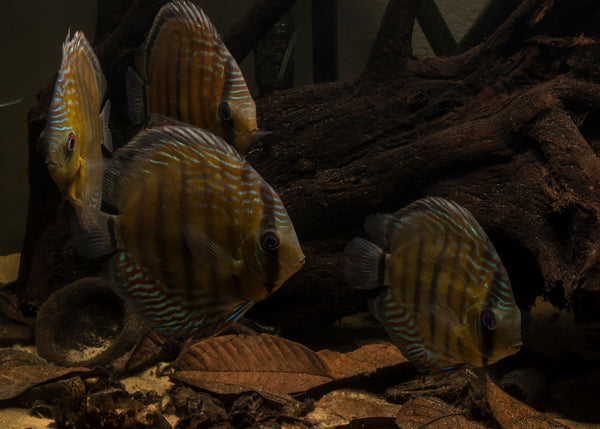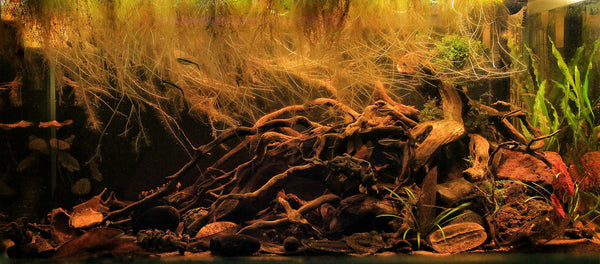- Continue Shopping
- Your Cart is Empty
Water quality and the botanical-style aquarium: Practices, potential, and speculation...
When it comes to managing a botanical-style aquarium, you are already at a sort of "disadvantage" when it comes to running a "spotlessly clean" aquarium. I mean, you've already committed to a tank which contains large quantities of materials, most of which are in the process of breaking down at any given time.
Correction...ALL of them!

What is the implication of all this "stuff" breaking down in our tanks?
There must be a thousand ways to set up an aquarium and operate it. In fact, its probably several times that amount. And no one can ever seem to agree what the "best" way to go is. And that's okay. There are a lot of cool approaches you can try. So, while we might disagree on the best approach or style, we all seem to have a common goal:
Providing the best possible environment for our fishes.
Pretty much every really serious aquarium hobbyist can agree on one thing: It's important to have information about what's going on in his or her aquariums. Observation, collection of data, and interpretation of the information gathered have been keys to our success in so many areas of endeavor in the hobby.
And our botanical-style aquariums are a bit of an enigma.
I mean, we have tanks with all of this stuff decomposing in the water, yet manage to maintain high water quality and stability for extended periods of time without any real "magic", in terms of procedure or equipment.
What gives?

And of course, not being a scientist makes it kind of challenging for me to make all kinds of assertions about water quality and chemistry, so I will at least try to focus on what we want to achieve, water quality-wise, and how botanical-style aquariums seem to be able to "pull it off" given their vast quantities of leaves, seed pods, etc.
Now, we kind of have a pretty good "handle" on which tests make the most sense for our pursuits. It's a given that ammonia, nitrite, pH and DKH are the key indicators which most hobbyist will want to know about.

And then, there are the tests which give us information on the quality of the environment we've created- nitrate and phosphate. Nitrate (NO3) is not necessarily considered "toxic" at a specific level, although a typical rule of thumb is to keep readings under 50 mg/l- or better still, 20mg/l or less, for most fishes at various stages of their life cycle.

Although there is no "lethal dose", as indicated above, and many fishes can tolerate prolonged exposure to up to 500 mg/l of nitrate, studies have revealed that prolonged exposure to elevated levels of nitrate may reduce fishes' immunity, affecting their internal functions and resistance to disease.
Many fishes can adapt- to a certain extent- to a gradual increase in nitrate over time, although long-term physiological damage can occur. And of course, some fishes are much more sensitive to nitrate than others, displaying deteriorating overall health or other symptoms at much lower levels..

One of the interesting things about nitrate is that it can and will accumulate and rise over time in the aquarium if insufficient export mechanisms (ie; water exchanges, lack of chemical or biological filtration capacity exist within the aquarium. This, of course, gives the impression that fishes are "doing okay" when the reality is that they are exposed to a long-term stressor.
The presence of plants, known for their utilization of nitrate as a growth factor, is also considered a viable way to reduce/export nitrates, along with overall good husbandry (ie; stable fish population, proper feeding technique, etc.)

In our botanical-filled, natural-style aquariums, I have personally never observed/measured high level of nitrate. In fact, with a good husbandry regime in place, undetectable (on a hobbyist-grade test kit, at least) levels of nitrate have been the norm for my systems. I think that the highest nitrate reading I've personally recorded in a botanical-style system which I maintained was around 10 mg/l.
Why is this?
Well, I personally feel that well-maintained systems, including our heavily botanically-influenced ones, offer a significant "medium" for the growth and proliferation of beneficial bacteria species, such as Nitrospira. I have a totally ungrounded "theory" that the presence of botanicals, although in itself a contributor to the the biological load on the aquarium, also is a form of "fuel" to power the identification process- a carbon source, if you will, to elevate levels of biological activity in an otherwise well-maintained system.

Okay, sounds like a lot of cobbled-together "mumbo jumbo", but I think there is something to this. I mean, when you think about it, a botanically-rich aquarium, with leaves and other materials, fosters bacteria, fungi, biofilms, and supports crustaceans and other organisms which can consume the botanicals as they breakdown, along with fish wastes and other organics. A sort of "on board" biological filtration system, if you will, with the added benefit that fishes will consume some of these organisms. Perhaps, (and I'm reaching here a bit) even the basis for a sort of "food web", something that we know exists in all natural aquatic ecosystems.
Something to think about!

The other measure of water quality that most of us should consider is phosphate (PO4). It's a salt of phosphoric acid- an inorganic chemical. It's an essential chemical for the growth of plants, and other living organisms. Phosphate gets a lot of "bad press" in the hobby-particularly the marine side- as a contributor to the growth and proliferation of algae, which it is. However, it's really only half of the equation, as algae only grows if nitrogen is also present...So, it's a contributor to algae issues and overall water quality- not the main culprit.

In the reef hobby, phosphate has been vilified as a growth inhibitor to coral, and all manner of additives, reactors, and removal media have been developed to combat it. The reality, IMHO, is that phosphate- although a great measure of overall water quality, tends not to become a problem in an otherwise well-managed aquarium. It gets into our systems in the first place via food, and will accumulate if mechanisms for its absorption/utilization or removal don't exist.

So, yeah- perform those regular water exchanges. Yet another arguement in favor of them!
Oh, and both nitrate and phosphate are typically present in tap water...so when I espouse the use of an expensive RO/DI unit to pre-treat your tap water, I'm recommending a means to eliminate it at the source, giving you at least a good start. Reverse osmosis/deionization units, albeit somewhat pricy, are, in my opinion, an essential piece of equipment for any serious hobbyist.
In general, the water quality of our botanical-influenced, natural systems is something worthy of a lot of research, experiments, and discussion in our community. There is so much interesting stuff happening in our tanks- and so many things we don't know...
Specifically, how very low pH aquariums are best kept biologically stable. That's a whole new frontier that we're really only starting to understand...
And at those extremely low pH levels? How does the nitrogen cycle fucntion?
Archaens. They sound kind of exotic and even creepy, huh?
Well, they could be our friends. We might not even be aware of their presence in our systems...If they are there at all.
Are they making an appearance in our low pH tanks? I'm not 100% certain...but I think they might be. Okay, I hope that they might be.
Refresher:
Archaeans include inhabitants of some of the most extreme environments on the planet. Some live near vents in the deep ocean at temperatures well over 100 degrees Centigrade! true "extremophiles!" Others reside in hot springs, or in extremely alkaline or acid waters. They have even been found thriving inside the digestive tracts of cows, termites, and marine life where they produce methane (no comment here) They live in the anoxic muds of marshes (ohhh!!), and even thrive in petroleum deposits deep underground.

(Image used under CC 4.0)
Yeah, these are pretty crazy-adaptable organisms. The old sayings that "If these were six feet tall, they'd be ruling the world..." sort of comes to mind, huh?
Yeah, they're beasts....literally.
Could it be that some of the challenges in cycling what we define as "lower ph aquariums" are a by-product of that sort of "no man's land" where the pH is too low to support a large enough population of functioning Nitrosomanas and Nitrobacter, but not low enough for significant populations of Archaea to make their appearance?
I'm totally speculating here. I could be so off-base that it's not even funny, and some first year biology major (who happens to be a fish geek) could be reading this and just laughing...
Of course, I still can't help but wonder- is this a possible explanation for some of the difficulties hobbyists have encountered in the lower pH arena over the years? Part of the reason why the mystique of low pH systems being "difficult to manage" has been so strong?
Could it be that we just need to go a LOT slower when stocking low pH systems?
Perhaps. Yeah, probably.
And then- you think about the pH levels in some natural, well-populated (by fishes!) blackwater habitats falling into the 2.8-3.5 range, you have to wonder what it is that makes life so adaptable to this environment. You have to wonder if this same process can- and indeed does -take place in our aquariums. And you have to wonder if we, as a hobby, simply aren't working with these tanks in a correct manner.

Particularly, when they fall into what we'd call "extreme" pH ranges. I wonder if the "crashes" and fears and all sorts of bad stuff we've talked about in the hobby for decades were simply the result of not quite understanding the "operating system?"
Things just work differently at those lower pH levels- in Nature, and in our aquariums. Even the toxicity of ammonia is different at lower pH levels.
A lot of strings to pull here...

I think the secret is out there...somewhere.
Who's running a really low pH aquarium out there? What are your challenges, concerns, etc?
And of course, there is much to learn about the function- both biologically and environmentally- of deep leaf litter beds in the aquarium. The potential for significant developments in establishing and managing these types of aquariums is there. The application of leaf litter for multiple functions, ranging from food production to nutrient sequestration to possibly even denitrification are just a few possibilities.

Even if the processes are not "new" to the aquarium hobby, the approach that we take- and the viability and performance of botanical-style aquariums IS different. It opens up all sorts of avenues to explore.
We have taken our first tentative footsteps beyond what has long been accepted and understood in the hobby, and are starting to ask new question, make new observations, and yeah- even a few discoveries- which will evolve the aquarium hobby in the future.
Stay diligent. Stay curious. Stay studious. Stay experimental. Stay bold. Stay open-minded...
And Stay Wet.
Scot Fellman
Tannin Aquatics
2 Responses
Scott Fellman
Thanks for sharing your experiences with this!
I think the plants are certainly an assist with nutrient export. I often wonder what TDS measures, in our decomposing- botanical-heavy tanks!
Scott
Joshua E Morgan
I was looking for an article like this! My licorice gourami tanks (with a PH in the mid to high 4’s) never had major nutrient problems and apparently did cycle (as it did rarely have non zero nitrate readings). The TDS would start at 20 ppm after the weekly 40% water change and DROP to about 10 ppm by the next water change…clearly the plants in the tank (chiefly water lettuce but also java moss, java fern, cabomba, and a few others) were ravenous :O










Scott Fellman
Author